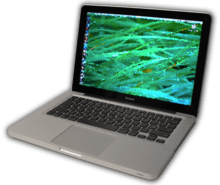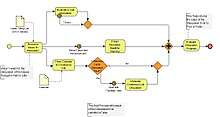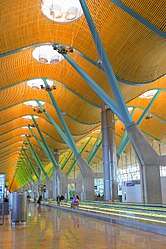Design
A design is a plan or specification for the construction of an object or system or for the implementation of an activity or process, or the result of that plan or specification in the form of a prototype, product or process. The verb to design expresses the process of developing a design. In some cases, the direct construction of an object without an explicit prior plan (such as in craftwork, some engineering, coding, and graphic design) may also be considered to be a design activity. The design usually has to satisfy certain goals and constraints, may take into account aesthetic, functional, economic, or socio-political considerations, and is expected to interact with a certain environment. Major examples of designs include architectural blueprints, engineering drawings, business processes, circuit diagrams, and sewing patterns.[1]
The person who produces a design is called a designer, which is a term generally used for people who work professionally in one of the various design areas—usually specifying which area is being dealt with (such as a textile designer, fashion designer, product designer, concept designer, web designer or interior designer), but also others such as architects and engineers. A designer's sequence of activities is called a design process, possibly using design methods. The process of creating a design can be brief (a quick sketch) or lengthy and complicated, involving considerable research, negotiation, reflection, modeling, interactive adjustment and re-design.
Design as a process
Substantial disagreement exists concerning how designers in many fields, whether amateur or professional, alone or in teams, produce designs. Kees Dorst and Judith Dijkhuis, both designers themselves, argued that "there are many ways of describing design processes" and discussed "two basic and fundamentally different ways",[2] both of which have several names. The prevailing view has been called "the rational model",[3] "technical problem solving"[4] and "the reason-centric perspective".[5] The alternative view has been called "reflection-in-action",[4] "co-evolution",[6] and "the action-centric perspective".[5]
The rational model
The rational model was independently developed by Herbert A. Simon,[7][8] an American scientist, and Gerhard Pahl and Wolfgang Beitz, two German engineering design theorists.[9] It posits that:
- Designers attempt to optimize a design candidate for known constraints and objectives.
- The design process is plan-driven.
- The design process is understood in terms of a discrete sequence of stages.
The rational model is based on a rationalist philosophy[3] and underlies the waterfall model,[10] systems development life cycle,[11] and much of the engineering design literature.[12] According to the rationalist philosophy, design is informed by research and knowledge in a predictable and controlled manner.
Example sequence of stages
Typical stages consistent with the rational model include the following:
- Pre-production design
- Design brief or Parti pris – an early (often the beginning) statement of design goals
- Analysis – analysis of current design goals
- Research – investigating similar design solutions in the field or related topics
- Specification – specifying requirements of a design solution for a product (product design specification)[13] or service.
- Problem solving – conceptualizing and documenting design solutions
- Presentation – presenting design solutions
- Design during production
- Development – continuation and improvement of a designed solution
- Testing – in situ testing of a designed solution
- Post-production design feedback for future designs
- Implementation – introducing the designed solution into the environment
- Evaluation and conclusion – summary of process and results, including constructive criticism and suggestions for future improvements
- Redesign – any or all stages in the design process repeated (with corrections made) at any time before, during, or after production.
Each stage has many associated best practices.[14]
Criticism of the rational model
The rational model has been widely criticized on two primary grounds:
The action-centric model
The action-centric perspective is a label given to a collection of interrelated concepts, which are antithetical to the rational model.[5] It posits that:
- Designers use creativity and emotion to generate design candidates.
- The design process is improvised.
- No universal sequence of stages is apparent – analysis, design and implementation are contemporary and inextricably linked.[5]
The action-centric perspective is based on an empiricist philosophy and broadly consistent with the agile approach[17] and amethodical development.[18] Substantial empirical evidence supports the veracity of this perspective in describing the actions of real designers.[15] Like the rational model, the action-centric model sees design as informed by research and knowledge. However, research and knowledge are brought into the design process through the judgment and common sense of designers – by designers "thinking on their feet" – more than through the predictable and controlled process stipulated by the rational model.
Descriptions of design activities
At least two views of design activity are consistent with the action-centric perspective. Both involve three basic activities.
In the reflection-in-action paradigm, designers alternate between "framing", "making moves", and "evaluating moves". "Framing" refers to conceptualizing the problem, i.e., defining goals and objectives. A "move" is a tentative design decision. The evaluation process may lead to further moves in the design.[4]
In the sensemaking–coevolution–implementation framework, designers alternate between its three titular activities. Sensemaking includes both framing and evaluating moves. Implementation is the process of constructing the design object. Coevolution is "the process where the design agent simultaneously refines its mental picture of the design object based on its mental picture of the context, and vice versa".[5]
The concept of the design cycle is understood as a circular time structure,[19] which may start with the thinking of an idea, then expressing it by the use of visual or verbal means of communication (design tools), the sharing and perceiving of the expressed idea, and finally starting a new cycle with the critical rethinking of the perceived idea. Anderson points out that this concept emphasizes the importance of the means of expression, which at the same time are means of perception of any design ideas.[20]
Philosophies of design
Philosophy of design is the study of definitions of design, and the assumptions, foundations, and implications of design. There are also countless informal or personal philosophies for guiding design as design values and its accompanying aspects within modern design vary, both between different schools of thought and among practicing designers.[21] Design philosophies are usually for determining design goals. In this sense, design philosophies are fundamental guiding principles that dictate how a designer approaches his/her practice. Reflections on material culture and environmental concerns (sustainable design) can guide a design philosophy. An example is the First Things First manifesto which was launched within the graphic design community and states "We propose a reversal of priorities in favor of more useful, lasting and democratic forms of communication – a mindshift away from product marketing and toward the exploration and production of a new kind of meaning. The scope of debate is shrinking; it must expand. Consumerism is running uncontested; it must be challenged by other perspectives expressed, in part, through the visual languages and resources of design."[22]
Approaches to design
A design approach is a general philosophy that may or may not include a guide for specific methods. Some are to guide the overall goal of the design. Other approaches are to guide the tendencies of the designer.
Some of these approaches include:
- Sociotechnical system design, a philosophy and tools for participative designing of work arrangements and supporting processes – for organizational purpose, quality, safety, economics and customer requirements in core work processes, the quality of peoples experience at work and the needs of society
- User-centered design, which focuses on the needs, wants, and limitations of the end user of the designed artifact.
- Critical design uses designed artifacts as an embodied critique or commentary on existing values, morals, and practices in a culture.
- Service design designing or organizing the experience around a product and the service associated with a product's use.
- Transgenerational design, the practice of making products and environments compatible with those physical and sensory impairments associated with human aging and which limit major activities of daily living.
- Participatory Design (originally co-operative design, now often co-design) is the practice of collective creativity to design, attempting to actively involve all stakeholders (e.g. employees, partners, customers, citizens, end users) in the design process to help ensure the result meets their needs and is usable. Participatory design is an approach which is focused on processes and procedures of design and is not a design style[23]
Types
Design can broadly be applied to various fields such as art, engineering and production.
Design and art
Today, the term design is generally used for what was formerly called the applied arts. The new term, for a very old thing, was perhaps initiated by Raymond Loewy and teachings at the Bauhaus and Ulm School of Design (HfG Ulm) in Germany during the 20th century.
The boundaries between art and design are blurred, largely due to a range of applications both for the term 'art' and the term 'design'. Applied arts can include industrial design, graphic design, fashion design, and the decorative arts which traditionally includes craft objects. In graphic arts (2D image making that ranges from photography to illustration), the distinction is often made between fine art and commercial art, based on the context within which the work is produced and how it is traded.
To a degree, some methods for creating work, such as employing intuition, are shared across the disciplines within the applied arts and fine art. Mark Getlein, writer, suggests the principles of design are "almost instinctive", "built-in", "natural", and part of "our sense of 'rightness'."[24] However, the intended application and context of the resulting works will vary greatly.

Design and engineering
In engineering, design is a component of the engineering process. Many overlapping methods and processes can be seen when comparing Product design, Industrial design and Engineering. The American Heritage Dictionary defines design as: "To conceive or fashion in the mind; invent," and "To formulate a plan", and defines engineering as: "The application of scientific and mathematical principles to practical ends such as the design, manufacture, and operation of efficient and economical structures, machines, processes, and systems.".[25][26] Both are forms of problem-solving with a defined distinction being the application of "scientific and mathematical principles". The increasingly scientific focus of engineering in practice, however, has raised the importance of more new "human-centered" fields of design.[27] How much science is applied in a design is a question of what is considered "science". Along with the question of what is considered science, there is social science versus natural science. Scientists at Xerox PARC made the distinction of design versus engineering at "moving minds" versus "moving atoms" (probably in contradiction to the origin of term "engineering – engineer" from Latin "in genio" in meaning of a "genius" what assumes existence of a "mind" not of an "atom").

Design and production
The relationship between design and production is one of planning and executing. In theory, the plan should anticipate and compensate for potential problems in the execution process. Design involves problem-solving and creativity. In contrast, production involves a routine or pre-planned process. A design may also be a mere plan that does not include a production or engineering processes although a working knowledge of such processes is usually expected of designers. In some cases, it may be unnecessary or impractical to expect a designer with a broad multidisciplinary knowledge required for such designs to also have a detailed specialized knowledge of how to produce the product.
Design and production are intertwined in many creative professional careers, meaning problem-solving is part of execution and the reverse. As the cost of rearrangement increases, the need for separating design from production increases as well. For example, a high-budget project, such as a skyscraper, requires separating (design) architecture from (production) construction. A Low-budget project, such as a locally printed office party invitation flyer, can be rearranged and printed dozens of times at the low cost of a few sheets of paper, a few drops of ink, and less than one hour's pay of a desktop publisher.
This is not to say that production never involves problem-solving or creativity, nor that design always involves creativity. Designs are rarely perfect and are sometimes repetitive. The imperfection of a design may task a production position (e.g. production artist, construction worker) with utilizing creativity or problem-solving skills to compensate for what was overlooked in the design process. Likewise, a design may be a simple repetition (copy) of a known preexisting solution, requiring minimal, if any, creativity or problem-solving skills from the designer.

Process design
"Process design" (in contrast to "design process" mentioned above) is to the planning of routine steps of a process aside from the expected result. Processes (in general) are treated as a product of design, not the method of design. The term originated with the industrial designing of chemical processes. With the increasing complexities of the information age, consultants and executives have found the term useful to describe the design of business processes as well as manufacturing processes.
Design disciplines
- Applied arts
- Architecture
- Automotive design
- Biological design
- Configuration design
- Communication design
- Costume design
- Design management
- Engineering design
- Experience design
- Fashion design
- Floral design
- Game design
- Graphic design
- Information architecture
- Information design
- Industrial design
- Instructional design
- Interaction design
- Interior design
- Landscape architecture
- Lighting design
- Modular design
- Motion graphic design
- Organization design
- Process design
- Product design
- Production design
- Property design
- Scenic design
- Service design
- Social design
- Software design
- Sound design
- Spatial design
- Strategic design
- Systems architecture
- Systems design
- Systems modeling
- Urban design
- User experience design
- User interface design
- Web design
See also
- Design elements and principles
- Design-based learning
- Design theory
- Design thinking
- Evidence-based design
- List of design awards
References
- Dictionary meanings in the Cambridge Dictionary of American English, at Dictionary.com (esp. meanings 1–5 and 7–8) and at AskOxford (especially verbs).
- Dorst, Kees; Dijkhuis, Judith (1995). "Comparing paradigms for describing design activity". Design Studies. 16 (2): 261–274. doi:10.1016/0142-694X(94)00012-3.
- Brooks, F.P. (2010) The design of design: Essays from a computer scientist, Addison-Wesley Professional. ISBN 0-201-36298-8.
- Schön, D.A. (1983) The reflective practitioner: How professionals think in action, Basic Books, USA.
- Ralph, P. (2010) "Comparing two software design process theories". International Conference on Design Science Research in Information Systems and Technology (DESRIST 2010), Springer, St. Gallen, Switzerland, pp. 139–153. doi:10.1007/978-3-642-13335-0_10.
- Dorst, Kees; Cross, Nigel (2001). "Creativity in the design process: Co-evolution of problem–solution" (PDF). Design Studies. 22 (5): 425–437. doi:10.1016/S0142-694X(01)00009-6.
- Newell, A., and Simon, H. (1972) Human problem solving, Prentice-Hall, Inc.
- Simon, H.A. (1996) The sciences of the artificial, MIT Press, Cambridge, MA, USA. p. 111. ISBN 0-262-69191-4.
- Pahl, G., and Beitz, W. (1996) Engineering design: A systematic approach, Springer-Verlag, London. ISBN 3-540-19917-9.
- Royce, W.W. (1970) "Managing the development of large software systems: Concepts and techniques," Proceedings of Wescon.
- Bourque, P., and Dupuis, R. (eds.) (2004) Guide to the software engineering body of knowledge (SWEBOK). IEEE Computer Society Press, ISBN 0-7695-2330-7.
- Pahl, G., Beitz, W., Feldhusen, J., and Grote, K.-H. (2007 ) Engineering design: A systematic approach, (3rd ed.), Springer-Verlag, ISBN 1-84628-318-3.
- Cross, N., (2006). T211 Design and Designing: Block 2, p. 99. Milton Keynes: The Open University.
- Ullman, David G. (2009) The Mechanical Design Process, Mc Graw Hill, 4th edition ISBN 0-07-297574-1
- Cross, N., Dorst, K., and Roozenburg, N. (1992) Research in design thinking, Delft University Press, Delft. ISBN 90-6275-796-0.
- McCracken, D.D.; Jackson, M.A. (1982). "Life cycle concept considered harmful". ACM SIGSOFT Software Engineering Notes. 7 (2): 29–32. doi:10.1145/1005937.1005943.
- Beck, K., Beedle, M., van Bennekum, A., Cockburn, A., Cunningham, W., Fowler, M., Grenning, J., Highsmith, J., Hunt, A., Jeffries, R., Kern, J., Marick, B., Martin, R.C., Mellor, S., Schwaber, K., Sutherland, J., and Thomas, D. (2001) Manifesto for agile software development.
- Truex, D.; Baskerville, R.; and Travis, J. (2000). "Amethodical systems development: The deferred meaning of systems development methods". Accounting, Management and Information Technologies. 10 (1): 53–79. doi:10.1016/S0959-8022(99)00009-0.
- Fischer, Thomas "Design Enigma. A typographical metaphor for enigmatic processes, including designing", in: T. Fischer, K. De Biswas, J.J. Ham, R. Naka, W.X. Huang, Beyond Codes and Pixels: Proceedings of the 17th International Conference on Computer-Aided Architectural Design Research in Asia, p. 686
- Anderson, Jane (2011) Architectural Design, Basics Architecture 03, Lausanne, AVA academia, p. 40. ISBN 978-2-940411-26-9.
- Holm, Ivar (2006). Ideas and Beliefs in Architecture and Industrial design: How attitudes, orientations and underlying assumptions shape the built environment. Oslo School of Architecture and Design. ISBN 82-547-0174-1.
- First Things First 2000 a design manifesto Archived 2011-12-19 at the Wayback Machine. manifesto published jointly by 33 signatories in: Adbusters, the AIGA journal, Blueprint, Emigre, Eye, Form, Items fall 1999/spring 2000
- "Co-creation and the new landscape of design" (PDF).
- Getlein, Mark (2008) Living With Art, 8th ed. New York, p. 121.
- American Psychological Association (APA): design Archived 2007-01-08 at the Wayback Machine. The American Heritage Dictionary of the English Language, Fourth Edition. Retrieved January 10, 2007
- American Psychological Association (APA): engineering Archived 2007-01-02 at the Wayback Machine. The American Heritage Dictionary of the English Language, Fourth Edition. Retrieved January 10, 2007
- Faste, R. (2001). "The Human Challenge in Engineering Design" (PDF). International Journal of Engineering Education. 17 (4–5): 327–331.
Bibliography
| Look up design in Wiktionary, the free dictionary. |
| Wikiquote has quotations related to: Design |
| Wikimedia Commons has media related to Design. |
| Library resources about Design |
